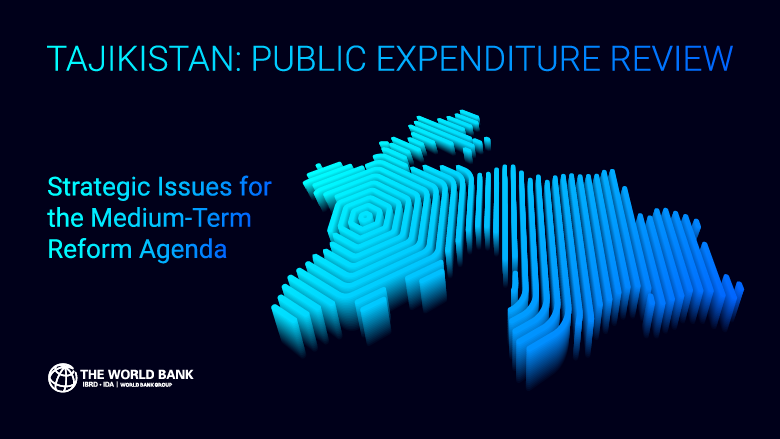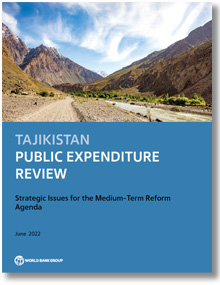
Summary
Tajikistan’s economy has grown rapidly since the late 1990s, at an average of about 7 percent between 1998 and 2019. Economic growth has held up well, even after the onset of the COVID-19 crisis, and is estimated to have increased to above 6 percent in 2021, from 4.5 percent last year.
However, Tajikistan’s young and fast-growing population still do not have access to sufficient job opportunities and high-quality public services such as healthcare, and education. In 2019, 26.3 percent of Tajikistan’s population lived below the national poverty line, and challenges persist in ensuring they receive access to high quality social assistance.
Addressing these challenges, and improving human capital requires higher and more efficient public spending on social services. It also calls for the private sector to have more room to grow and compete, so it can create the job opportunities needed for the country’s young, rapidly expanding labor force.
The development of the Rogun hydropower plant (HPP) is another opportunity for Tajikistan to harness its comparative economic advantage in clean energy generation. Rogun is an ambitious and costly public investment that increases the need for more sustainable and disciplined fiscal policy and improvements in the quality and efficiency of other public spending in Tajikistan.
The affordability of Rogun and the benefits it can have for Tajikistan’s economy also depend on complementary reforms that increase private sector competition, improve the environment for broader and more diversified external trade, improve the regulatory environment, enhance the rule of law, and increase the efficiency and stability of the financial system.
Effective management of the government’s budget will also be essential—fiscal space is already highly constrained, fiscal and public debt risks are high, and the efficiency and effectiveness of public spending is generally low. Large COVID-related spending since 2020 has created further spending pressures.
The review covers eight themes.
1. Addressing Macro-Fiscal Challenges
This chapter analyses Tajikistan’s economic and fiscal performance: the main drivers of growth, trends of budget revenues and spending, and the evolution of public debt. The chapter concludes that the main fiscal policy priority over the medium-term should be to reduce risks of debt distress while creating the budgetary space to increase social assistance and finance investments in human capital.
This can be achieved through gradual fiscal consolidation, establishing a zero non-concessional borrowing policy, and other measures that would help reduce potential sources of fiscal risk.
2. Attaining Sustainable Public Financial Management
This chapter analyses how Tajikistan could strengthen its public financial management (PFM) systems to improve the effectiveness and efficiency of public spending. The chapter provides recommendations for better budget planning, sustained treasury and accounting reforms, improvements in public procurement, and measures to mitigate fiscal risks.
3. Reforming Tax Policy and Administration for Sustainable and Inclusive Growth
This chapter analyses Tajikistan’s revenue trends and the quality of tax policy and administration. Tajikistan’s tax revenues as a share of GDP are higher than most relevant comparators, and Tajikistan faces a challenge in balancing the level and efficiency of tax collection with the need for an investment-friendly business environment to increase private-sector led growth and job creation in the country.
One important way to achieve this balance is to improve tax administration, specifically to increase voluntary compliance and reduce administrative burdens on businesses.
4. Improving Efficiency of Public Investment Management
Public investment in Tajikistan amounts to 35-38 percent of all public spending and is extraordinarily high as a share of GDP, by regional and international standards, at about 13-15 percent. The chapter concludes that weak project selection and management, combined with the enormous fiscal burden of energy sector investments, severely undermines the efficiency of public investments in Tajikistan, and therefore the efficiency of a sizeable part of all public spending.
Therefore, a main challenge to sustain high growth and generate rapid improvements to living standards is to improve the quality and efficiency of Tajikistan’s public investment system.
5. Improving Health
Tajikistan trails other Central Asian countries in key health indicators such as life expectancy, child mortality, and stunting, leading to a substantial loss of human capital. The chapter recommends increasing public healthcare spending to levels more appropriate for ensuring citizens’ access to a package of essential health benefits. At the same time, the effectiveness and efficiency of public healthcare spending needs to be improved.
6. Upgrading Education
Education spending in Tajikistan relies heavily on revenues transferred to, and collected by, subnational governments, which weakens the stability and predictability of the sector’s finances. In 2020, subnational governments financed over 80 percent of total education spending in Tajikistan. More than 93 percent of schools and all preschools relied on revenues generated by subnational governments.
The challenge for the government is to keep abreast of population growth of about 2 percent per year and rapidly rising demand for schools, teachers, educational materials, and other inputs. The population is expected to increase by a cumulative 20.7 percent between 2021 and 2030, implying a significant increase in education spending.
7. Reforming the Pension System
Tajikistan’s pension expenditures as a share of GDP are the smallest among all former Soviet Republics. This reflects the country’s low wages, young population, modest pension benefits, and high levels of informality and outward labor migration. In the next five years, the total number of pensioners will grow by 36 percent, to 1 million people. Tajikistan needs to urgently reform its pension system to help manage the worsening demographic trends and social pressures.
8. Improving Intergovernmental Fiscal Relations
Subnational governments play a key role in funding social spending in Tajikistan, but the absence of effective rules and regulations weaken subnational public service delivery. Almost 90 percent of funding for general education and 70 percent of funding for healthcare is channeled through subnational governments.
However, funding transfers from central to subnational governments are ad-hoc and unsystematic, reducing the quality and predictability of subnational budgets. The chapter recommends moving to a more transparent, rules-based, and predictable intergovernmental fiscal relationship to help address challenges in social service delivery and advance Tajikistan’s strategic development objectives.
Recommendations
The PER recommends reforms in several key policy areas. First, adopting a new approach to fiscal policy, both on the revenue and expenditure sides of the budget, could facilitate adherence to fiscal discipline and support more inclusive growth agenda.
Second, revamping the tax system by reducing exemptions could broaden the tax base and alleviate distortions, while enhancing taxes on goods with negative externalities could strengthen incentive structures.
Third, increasing investment in human capital could help ensure an inclusive and sustainable post-pandemic recovery and productivity of the Tajik economy in the long run.
Fourth, reforming public investment and public financial management systems could yield efficiency gains, improve governance, and strengthen social and economic inclusion.
About the PER:
Public finances play a critical role in supporting growth and well-being in Tajikistan. This Public Expenditure Review (PER) examines policy options to help improve the sustainability, effectiveness, efficiency, transparency, and accountability of Tajikistan’s public finances, and how they can be used better to increase growth and raise living standards.
The PER was developed based on inputs from various teams in the Government of Tajikistan, including the Ministry of Finance, the Ministry of Economic Development and Trade, the Tax Committee and Customs Service, the State Committee on Investment and State Property Management, the Ministry of Education and Science, the Ministry of Health and Social Protection of the Population, the State Pension Fund of Tajikistan and other government agencies.
